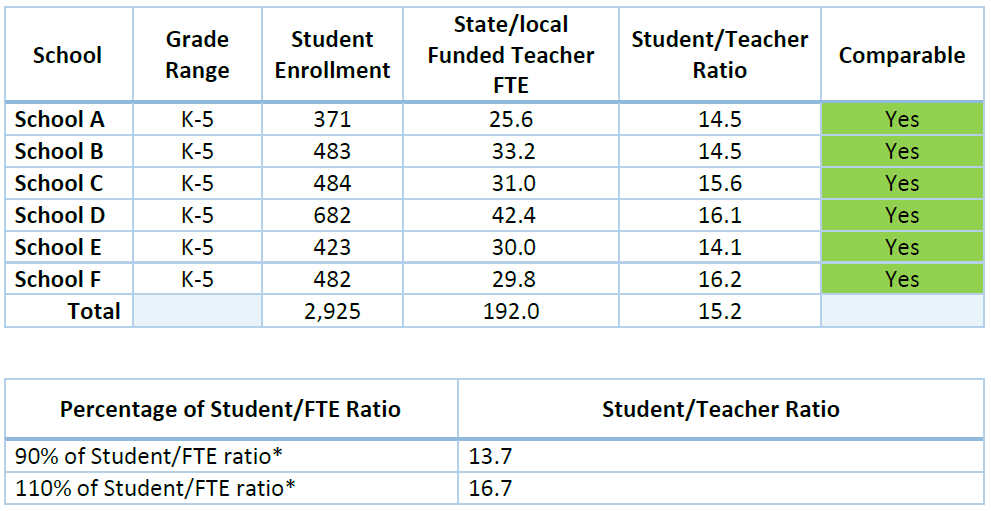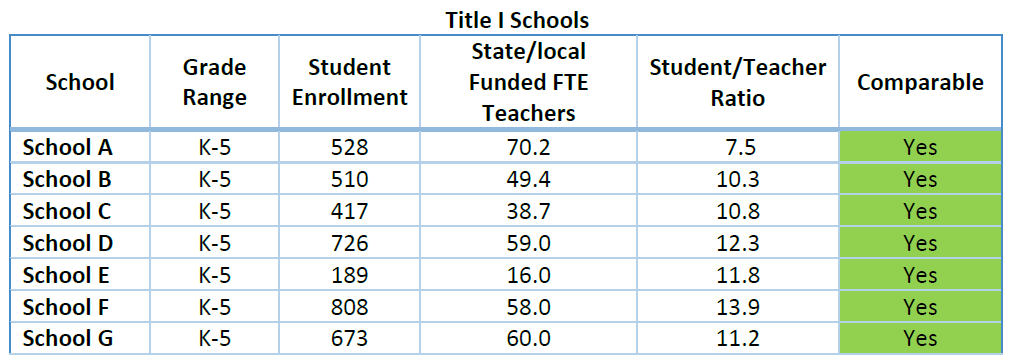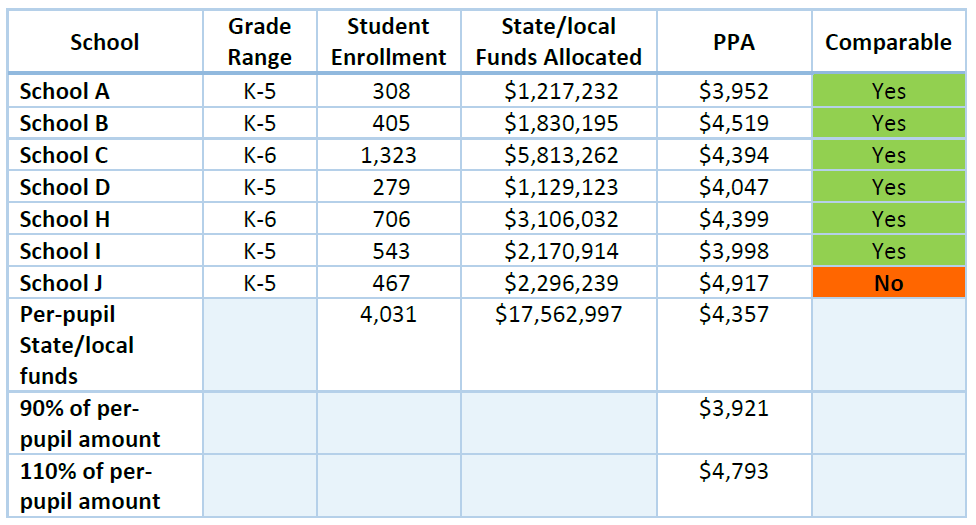You are here
Title I, Part A Comparability
Title I, Part A Comparability
The Elementary and Secondary Education Act (ESEA), reauthorized as the Every Student Succeeds Act (ESSA), States that the purpose of Title I, Part A is to “provide all children significant opportunity to receive a fair, equitable, and high-quality education, and to close educational achievement gaps.” Title I, Part A funds are intended to provide additional resources for students from high-poverty neighborhoods who are at risk of not meeting State academic standards, beyond what is provided with State and local funds. Section 1118 of ESSA requires local educational agencies (LEAs) to provide State- and locally-funded services in schools receiving support under Title I, Part A that, taken as a whole, are at least comparable to services provided in schools that do not receive support under Title I, Part A.
Obligation to Demonstrate Comparability
LEAs must submit a demonstration of compliance with the Comparability requirements if the LEA has at least one Title I school, with at least 100 students, in a grade span that has two or more schools.
LEAs are exempt from demonstration of compliance with the Comparability requirements if they:
- Do not accept Title I, Part A funds, or
- Only have one school per grade span
LEAs who are not exempt may exclude any schools that have fewer than 100 students from their Comparability analyses.
In prior years, the Colorado Department of Education (CDE) had exempted districts with fewer than 1,000 students from Comparability analyses. However, based on recent U.S. Department of Education’s (ED) guidance, enrollment of less than 1,000 students does not automatically exempt districts from Comparability analyses.
Annual Requirements
CDE presumes that LEAs are meeting ESSA Comparability requirements if they have provided written assurance in their annual ESEA Consolidated Application that they have established and implemented all of the following:
- An LEA-wide salary schedule, and
- A Policy to ensure equivalence among schools in:
- Teachers, administrators, and other staff.
- Provision of curriculum materials and instructional supplies.
LEAs required to demonstrate Comparability will conduct local analyses prior to or at the beginning of the school year and make any necessary adjustments as early as possible to minimize disruption for students. CDE provides an Excel tool, the Alternative Comparability Calculator, to help LEAs perform these analyses based on their specific Title I school configurations. LEAs must maintain annual documentation of Comparability and be prepared to submit Comparability documentation to CDE every two years, if requested.
In order to reduce burden on LEAs, CDE performs Comparability calculations using Student October and HR Snapshot data. HR data includes teacher full-time equivalent (FTE) paid with State or local funds (primarily job class code 201), excluding Federally-funded FTEs. If CDE is able to demonstrate Comparability on behalf of the LEA, the LEA is not required to submit any additional analyses or evidence to CDE. If CDE is not able to demonstrate Comparability on behalf of the LEA, the LEA must provide evidence of Comparability using the Alternative Comparability Calculator or provide a Comparability Action Plan detailing steps to achieve compliance.
Methods to Calculate Comparability
Comparability calculations fall into two major categories, depending on the LEA’s Title I school configuration: all schools in the grade-span receive Title I, Part A funds or some schools in the grade span receive Title I, Part A funds.
Grade Span Versus Districtwide Comparison Alternative Method
LEAs may compare State and local funding for schools in each grade span or districtwide. LEAs also have the option to submit a separate calculator for each type of school configuration in their district (e.g. K-8, K-12, 6-12, etc).
All schools in the grade-span receive Title I, Part A funds.
When all schools in a grade span receive Title I, Part A funding, each school’s student/teacher ratio is compared to the overall grade span ratio. Each school needs to be within 10% of the overall student/teacher ratio to be comparable. Schools with lower student/teacher ratios are considered to be over-served based on State/local funds, and those with higher student/teacher ratios are considered to be under-served with State/local funds.
In the following example, the total student/teacher ratio is 15.2. For schools to demonstrate Comparability, they must have a student/teacher ratio within 10% of the total (or, in other words, they must have a student/teacher ratio that falls between 90% of the overall student/teacher ratio and 110% of the overall student/teacher ratio). All Title I schools in this example are comparable because all student/teacher ratios fall within 10% (between 13.7 to 16.7 students per teacher) of the grade span overall (15.2 students per teacher).

Some schools in the grade span accept Title I, Part A funds and others do not.
When some schools in a grade span receive Title I, Part A funding and others do not, each Title I school’s student/teacher ratio is compared to the overall ratio for non-Title I schools. Title I schools should not exceed the non-Title I ratio by more than 10%. Schools with higher student/teacher ratios are considered to be underserved with State/local funds.
In the following example, the total student/teacher ratio for non-Title I schools is 12.8. In order for Title I schools to be comparable, their student/teacher ratios cannot exceed 14.1 (110% of 12.8). All Title I schools in this example are comparable because none of their student/teacher ratios are greater than 14.1.



High-Low Enrollment or Poverty Alternative Method
If FTE calculations do not demonstrate comparability and school data supports high-low band analyses (e.g., when there are large differences in enrollment or poverty levels), the ED allows LEAs to conduct Comparability analyses by separate enrollment bands. For example, a high-enrollment Title I school that is not comparable to the average non-Title I school can be compared to the district’s high-enrollment non-Title I schools. Similarly, high-poverty Title I schools can be compared to high-poverty non-Title I schools.
Per-Pupil Allocation Alternative Method
LEAs with Title I schools that were not comparable, based on teacher FTE analyses and any applicable high-low band analyses, may also use the per-pupil allocation (PPA). LEAs using the PPA alternative methodology or calculator should be consistent by including the same categories of educational resources and materials purchased with State and local funds across schools. For example, if teaching paraprofessional, librarian, and/or counselor salaries are included in one school, they should be included in all others. If curriculum material costs are included for some, they should be included for all.
The PPA alternative method requires the LEA to demonstrate that the per-pupil allocation for educational materials and resources from State and local funds for each Title I school is comparable to non-Title I schools in the grade span. When all schools in the grade span are Title I, each school’s PPA should fall between 90% and 110% of the grade span average.
In the example below, all schools operate Title I programs and the PPA for each should be $3,921 - $4,793. The allocation for School J is $4,917, which is more than 10% above the average because its PPA is $4,917, which is greater than the 110% Per Pupil Amount of $4,793. School J appears to be over-served with State and local funds. The LEA would need to work with their ESEA regional contact and other Federal Programs staff to justify and document why School J required disproportionally more State and local funds. If there is not just cause for over-serving School J, in this example, the LEA must make appropriate adjustments as early in the school year as possible.

Salary Equivalence Alternative Method
LEAs with a districtwide salary schedule may provide a written assurance of its policies to ensure equivalence among schools in teachers, administrators, and other staff in each school, and to ensure the equivalence among schools in the provision of curriculum materials and instructional supplies. LEAs must also maintain records demonstrating that the policies were implemented and resulted in equivalence among schools in staffing, materials, and supplies.
Student-Instructional Staff Ratio Alternative Method
LEAs may compare the number of students per staff person in Title I and non-Title I schools. For this method, only include instructional staff and apply categories of staff in the same manner across all schools included in the calculation. Remember to count paraprofessionals separately from classroom teachers.
Comparability and Supplement, Not Supplant (SNS)
Comparability’s focus is educational materials and resources specifically. Comparability should not be confused with SNS, which ensures that Title I schools receive the funds they would have received if they had not participated in the Title I, Part A program. While Comparability and SNS requirements both examine how the LEA distributes State and local funds/resources to schools, they are separate tests that measure different aspects of the supplemental nature of Title I, Part A funds. As such, demonstration of Comparability may not meet SNS demonstration requirements and vice versa. The following scenarios illustrate how LEAs may satisfy one requirement while violating the other.
Note: Although other ESSA Titles do not have a Comparability provision, Titles II, III, and IV do have SNS provisions. For additional information about SNS, please visit the websites for each of the other Title programs.
Resources
The Office of Program Effectiveness in the Federal Programs & Supports Unit along with the Office of Data Services, host webinars to review the Comparability requirements, discuss data entry into the HR collection, and demonstrate how to use the Alternative Comparability Calculator.
-
Comparability Action Plan - SmartSheet
-
Demonstrating Comparability - PowerPoint
For Additional Information Contact:
Tina Negley
Program Effectiveness Supervisor
720-766-2793
negley_t@cde.state.co.us
Evita Byrd
ESEA Title I and IV Specialist
720-347-5667
byrd_e@cde.state.co.us


Connect With Us





